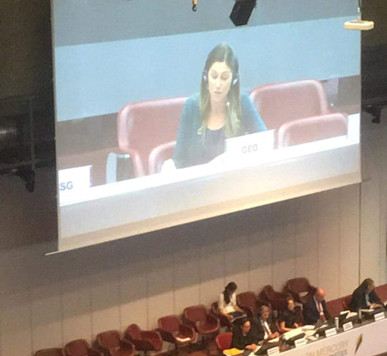Blog / December 12, 2019


The Group on Earth Observations (GEO) participated in the latest meeting of the Minamata Convention on Mercury at the end of November in Geneva.
Mercury and its related compounds pose a direct and immediate threat to human health, our environment and numerous species throughout ocean and terrestrial ecosystems. Some of the leading causes of mercury entering our environment include artisanal and small-scale gold mining, the burning of coal and coal-fired power plants, and the use of mercury in dental amalgam.
Earth observations, including in situ measurement (on site) and remote sensing satellites (from above), associated with chemical transport models runs, are methods used to track the dispersion and concentrations of chemical pollutants, including mercury, that are released into the environment.
For the first time ever, GEO participated as an official Observer at the Third Conference of the Parties (COP3) to the Minamata Convention on Mercury, effective since 2017 and ratified by 114 countries. Organized by the United Nations Environment Programme, a week-long event from 25-29 November focused on coordinating actions and implementing the Convention.
“Our Observer status to the Minamata Convention is one additional step in fulfilling GEO’s mandate to be recognised as a leading intergovernmental organization that provides crucial data for decision making about the Earth’s environment”, said Gilberto Camara, GEO Secretariat Director.
“There are clear links between climate change and mercury pollution: the burning of coal, oil and wood as fuel can cause mercury to become airborne and go into the atmosphere. Also, the thawing of permafrost accelerated by climate change will cause the biggest pool of mercury on the planet that has been trapped in the frozen ground to be released into waterways, soil, and air. Earth Observations are critical to monitor such changes”, said Sara Venturini, Climate Coordinator and lead for the Minamata Convention engagement at the GEO Secretariat.
The GEO Secretariat delivered a statement to the Plenary, calling for Parties to engage with and support the GEO Flagship, Global Observation System for Mercury (GOS4M). Read the full statement here.


GOS4M supports the Minamata Convention on Mercury Secretariat, the UNEP Global Mercury Partnership and the Minamata Effectiveness Evaluation ad hoc group and Global Monitoring framework.
In particular, GOS4M contributes to article 19 of the Minamata Convention that states that all monitoring activities should build on existing monitoring networks, where appropriate. To this end, the Flagship will also enhance the activity of the Mercury Air Transport and Fate Research Partnership Area of UN Environment by involving regional programmes and networks. GOS4M will provide an advanced environment where continuous information on mercury concentrations in ambient air and fluxes as well as outputs from validated regional and global scale atmospheric and marine models will be released as web services. The GOS4M Knowledge Hub under development as part of the GEO Knowledge Hub is aimed at increasing the availability and quality of Earth Observation data and information to contribute to the tracking of mercury released to the global environment and, where appropriate, anticipate changes in the environmental cycling of mercury.
COP3 participants were able to learn more about GEO at a dedicated booth hosted at the Mercury Air Transport and Fate Research Partnership Area.


GEO also took part in the Knowledge Lab on Global Mercury Monitoring organized by the Biodiversity Research Institute (BRI) and partners on 26 November. Sergio Cinnirella, Researcher at Italy’s National Research Council (CNR), discussed the work of GOS4M and the role of the GEO Knowledge Hub in delivering data to support to the Parties of the Minamata Convention and delegates. View the photos of the event on Flickr.
Other areas where GEO is working on mercury monitoring include the newly launched E-SHAPE project, supported by Horizon 2020, that is developing operational Earth Observation services with and for users. E-shape is developing services related to the health surveillance of pollutants. Also, the work of ERA-PLANET related to big data generated by in-situ or satellite platforms was presented. The overarching goal of ERA-PLANET is to strengthen the European Research Area in the domain of Earth Observation in coherence with the European participation to GEO and the Copernicus programme.
During the plenary in Geneva it was agreed that the host of the next COP to the Minamata Convention will be Indonesia. COP4 will take place in Bali in 2021.
Thank you for your subscription to the GEO Week 2019 mailing list.